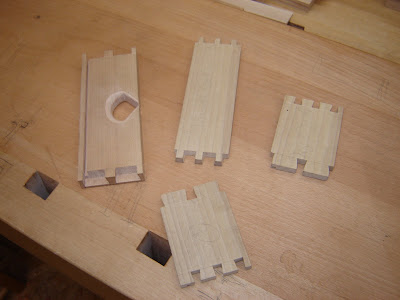
Our first couple weeks at the school have seen us all experience a lot of firsts...first real work bench, first time sharpening to a razor's edge, first time making a wooden plane and most importantly, first shavings with our new planes! It is a wonderful feeling, to make a tool with as much care and precision as you possess and then to see it carve off a beautifully thin, "full width, full length" shaving that gently floats to the floor. When it's really thin Robert exclaims something like, "That's less than half a thou!".
On our first day we were asked to introduce ourselves and say a little about why we were here. I said that I was here to learn how to slow down and enjoy the process of doing my work, ahead of thinking about the product. Three weeks in I'm quite pleased with the results I've achieved but I don't think I've slowed down much, if at all. After the last few years I'm hardwired to work efficiently and I'm struggling with the pace. I take solace however in a quote I found by James Krenov. He said, " Good work makes its own pace." I look forward to further working on this, especially as the tasks we are given become that much more complex and challenging.

I was not familiar with James Krenov until I looked into coming to this school and discovered that it was all based on his teaching and his ideas. While reading his first book, A Cabinet Maker's Notebook I really gained an appreciation for wood as more than just another material and for woodworking as much more than just building with wood. He taught that in order to be a craftsman in the true sense of the word, you had to be connected to the wood and work with your heart, your hands and your eyes. Sadly, on September 10th which was our third day of school, he passed away. It was really special to be at the school and feel connected to the "legend" as Robert Van Norman, who is our teacher and the founder of the school has enjoyed JK as a friend and mentor for twenty or so years. It is really special to be part of the school that as Robert explains, Krenov felt was his legacy.
I'm going to attach a bunch of photos of various things such as the making of our smoothing plane, our jointing plane and our coopering plane. We have also done an exercise with grain graphics and the shaping of a "gumby" leg. For now I will spare you too many details but perhaps will get into it more later on.
The first two here are my smoother place in various stages of construction. The third is more or less complete. It was made from Jatoba which is a really hard, stable wood; good for making planes.
This is the pieces that I cut to make my jointer plane ( light coloured Maple) and my coopering plane (darker, again Jatoba). We shaped the cross pins for our planes (the part that holds the blade in) by hand with chisels and files.
Some Tibetan monks were doing a Mandala at a church in Davis Bay. They create an incredibly intricate design out of very fine sand. It takes a week to create and then they ceremoniously destroy it. It was a lesson in patience and process for all of us.
Our first lesson in grain graphics was amazing. We started with a 4 by 4 piece of wood and n order to get the grain to cooperate with the curve of our leg we had to cut it out so that the end grain ran diagonally across the top.
Then, when you cut out the concave shape to the leg, the grain is manipulated into following the shape. Almost like magic, so simple but so cool! Notice how in the first photo the grain curves upwards? Then in the second, the grain has been altered to curve down along the shape of the leg....
Ok, goodnight. I'll share more soon.




















































